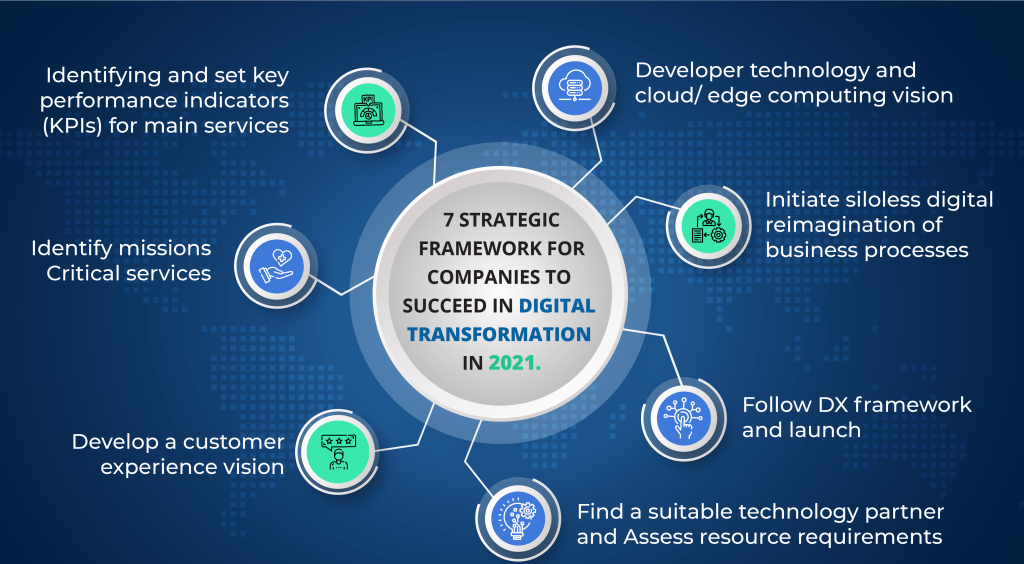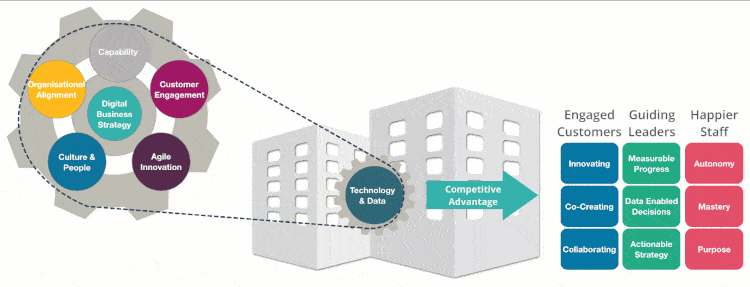Address
Office B-23, Sector 67, Noida , 201301
Work Hours(IST)
Mon to Fri: 9:00am – 6:30pm
Weekend: 10:00am – 5:00pm
Address
Office B-23, Sector 67, Noida , 201301
Work Hours(IST)
Mon to Fri: 9:00am – 6:30pm
Weekend: 10:00am – 5:00pm

Digital transformation is a process that has the potential to transform your business and improve its performance. Digital transformation can be defined as a series of business processes which will enable organizations to digitally connect with its customers, employees, partners and suppliers in every aspect of their operations through various digital channels. “Digital” is a term used to describe technology that is connected, but in many ways it could also be considered as modern technology. Digital transformation is the process of using digital technologies to change how businesses operate, deliver value to customers, and interact with employees.

Digital transformation can help reduce costs for businesses by allowing them to avoid the expenses incurred in maintaining legacy systems and infrastructure. By using cloud-based solutions, businesses can reduce the cost of hardware, software and connectivity while also gaining access to new features and functionality.
Increased Productivity
The use of digital technologies has allowed companies to increase their productivity by improving employee efficiency and performance. Employees are able to complete tasks quickly by using simple tools such as smartphones and tablets, which allows them to be more effective than they were before. This leads to fewer errors which can lead to higher quality products or services being delivered on time.
Companies that have adopted digital strategies have seen their risk levels reduced as they are now able to manage data securely through the use of encryption technology. They are also able to implement cybersecurity measures which will help keep sensitive information safe from hackers who may want access to this information in order to steal identities or financial assets belonging to the company.
With the help of digital tools, companies can track their products from manufacturing stage till delivery stage and ensure that they are delivered on time. This helps customers to get better service and also helps companies to understand their customers better so that they can deliver optimal customer satisfaction experience.
With the help of digital marketing, companies can evolve their marketing strategies by reaching out to their target audience at the right time and place, using advanced analytics tools that allow them to better understand who they are talking to and what they want from your brand or product offering.
One of the biggest benefits of digital transformation is that it helps in increasing revenue generation for your business. With new digital strategies and technologies, businesses can increase their sales without having to invest in new products or services as well as advertising campaigns. Also, every sale made online has a higher chance of being converted into a sale offline due to minimal efforts required from the customer’s side. This increases your chances of generating more sales and profits for your business.
In today’s fast-paced business environment, digital transformation is no longer just an option – it’s a necessity. Companies that fail to embrace digital technologies risk falling behind their competitors and losing market share. However, implementing a digital transformation strategy is not just about adopting new technologies – it also requires strong leadership.
Leadership plays a critical role in successfully navigating the complex and ever-evolving landscape of digital transformation. Firstly, leaders need to be able to identify the right technologies and tools that will help their organization achieve its goals. This requires a deep understanding of the business, its processes, and its customers. Leaders need to be able to analyze data and trends, and make informed decisions about which tools and technologies to invest in.

Once the right technologies have been identified, leaders need to create a culture of innovation and experimentation within their organization. This means creating an environment where employees are encouraged to try new things, take risks, and learn from their mistakes. Leaders need to be able to communicate the benefits of digital transformation to their employees and get them on board with the vision for the future.
In addition to creating a culture of innovation, leaders also need to ensure that their organization has the right talent and skills to implement a digital transformation strategy. This means hiring people with the right technical expertise, as well as those who are adaptable and can learn new skills quickly. Leaders need to be able to identify skills gaps within their organization and provide training and development opportunities to bridge those gaps.
Finally, leaders need to be able to manage the change that comes with digital transformation. This means communicating with employees about the changes that are happening, and addressing any concerns or resistance that may arise. Leaders need to be able to inspire and motivate their employees to embrace the changes and see the opportunities that digital transformation can bring.
With effective leadership, organizations can successfully navigate the digital landscape and stay competitive in today’s digital world.
A Digital Transformation Framework is a step-by-step guide that helps businesses navigate the complex process of digital transformation. It provides a structured approach to transforming business operations and processes, taking into account the unique needs and goals of the organization. By following a Digital Transformation Framework, businesses can ensure that their digital transformation journey is well planned and executed, resulting in a successful outcome.

The first step in any digital transformation journey is to define the vision and objectives. This involves identifying the business goals, understanding the current state of the organization’s digital capabilities, and defining the desired future state.
The next step is to assess the current state of the organization’s digital capabilities. This involves conducting a thorough analysis of the existing technology infrastructure, business processes, and workforce skills.
Based on the assessment, the next step is to identify the gaps between the current state and the desired future state. This helps to determine the areas that require the most attention during the transformation process.
Once the gaps have been identified, the next step is to develop a roadmap for the digital transformation journey. This involves defining the key initiatives, timelines, and budgets required to achieve the desired future state.
With the roadmap in place, the next step is to implement the key initiatives identified. This may involve implementing new technology solutions, upgrading existing systems, or reengineering business processes.
The final step in the Digital Transformation Framework is to monitor and evaluate the progress of the transformation journey. This allows businesses to identify any issues or challenges that arise and make necessary adjustments to ensure the success of the initiative.
By following a structured approach, businesses can ensure that their digital transformation journey is well-planned and executed, resulting in a successful outcome. So, if your business is considering embarking on a digital transformation journey, be sure to use a Digital Transformation Framework to guide you every step of the way.
Ultimately, digital transformation is a process. It doesn’t happen overnight and it doesn’t mean that an organization is suddenly “digital,” but it does mean that an organization is moving forward, embracing opportunities that may have previously been ignored. It’s an ongoing process that requires leaders who are engaged and excited about the possibilities. It also needs a framework for success to ensure that organizations are focused on the right goals and measurements.

Proeffico is a company that helps enterprises with their digital transformation journey by leveraging its experience of over many years in providing best-in-class solutions to business leaders across the globe. Our common goal is to empower our clients with insight and guidance that helps them innovate and grow faster.
Know what a digital transformation is already? Discover more about online business.
![]()